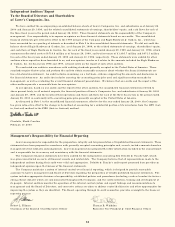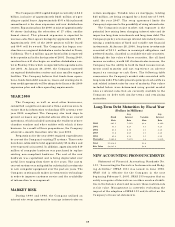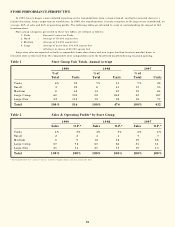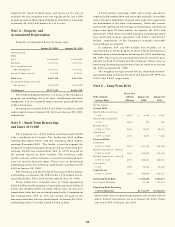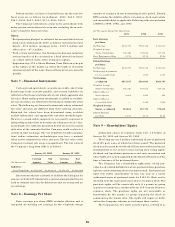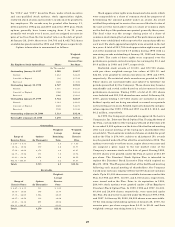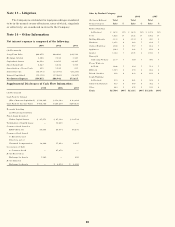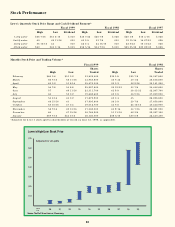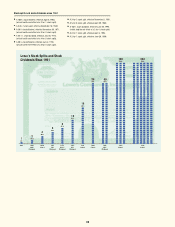Lowe's 1999 Annual Report Download - page 25
Download and view the complete annual report
Please find page 25 of the 1999 Lowe's annual report below. You can navigate through the pages in the report by either clicking on the pages listed below, or by using the keyword search tool below to find specific information within the annual report.
23
Notes to Consolidated Financial Statements
Years Ended January 28, 2000, January 29, 1999 and January 30, 1998
Note 1 – Summary of Significant
Accounting Policies
The Company is the world’s second largest home improve-
ment retailer serving more than four million do-it-yourself and
commercial business customers weekly. The Company operated
576 stores in 37 states from coast to coast at January 28, 2000.
Below are those accounting policies considered to be significant.
Fiscal Year – The Company’s fiscal year ends on the Friday
nearest January 31. The fiscal years ended January 28, 2000,
January 29, 1999 and January 30, 1998 each had 52 weeks. All
references herein for the years 1999, 1998 and 1997 represent
the fiscal years ended January 28, 2000, January 29, 1999 and
January 30, 1998, respectively.
Principles of Consolidation – The consolidated financial
statements include the accounts of the Company and its subsid-
iaries, all of which are wholly owned. All material intercompany
accounts and transactions have been eliminated.
Stock Split – On May 29, 1998, the Board of Directors
declared a two-for-one stock split on the Company’s common
stock. One additional share was issued on June 26, 1998 for each
share held by shareholders of record on June 12, 1998. The
accompanying consolidated financial statements, including per
share data, have been adjusted to reflect the effect o f the stock split.
Use of Estimates – The preparation of the Company’s
financial statements in conformity with generally accepted
accounting principles requires management to make estimates
and assumptions that affect the reported amounts of assets and
liabilities and disclosure of contingent assets and liabilities at the
date of the financial statements and reported amounts of rev-
enues and expenses during the reporting period. Actual results
could differ from those estimates.
Cash and Cash Equivalents – Cash and cash equivalents
include cash on hand, demand deposits, and short-term invest-
ments with original maturities of three months or less when
purchased.
Investments – The Company has a cash management pro-
gram which provides for the investment of excess cash balances in
financial instruments which have maturities of up to five years.
Investments, exclusive of cash equivalents, with a maturity date of
one year or less from the balance sheet date are classified as short-
term investments. Investments with maturities greater than one
year are classified as long-term. Investments consist primarily of
tax-exempt notes and bonds, municipal preferred tax-exempt
stock and repurchase agreements.
The Company has classified all investment securities as
available-for-sale, and they are carried at fair market value.
Unrealized gains and losses on such securities are included in
accumulated other comprehensive income in shareholders’
equity.
Derivatives – The Company does not use derivative finan-
cial instruments for trading purposes. Interest rate swap and cap
agreements, which are occasionally used by the Company in the
management of interest rate exposure, are accounted for on a
settlement basis. Income and expense are recorded in the same
category as that arising from the related liability. The Company
is currently utilizing an interest rate swap agreement to manage
interest rates on certain mortgages. Variable rates on mortgages,
totaling $25 million, are being swapped for a fixed rate of 7.94%
until the year 2007. The swap agreement limits the Company’s
exposure to the possibility of rising interest rates.
Accounts Receivable –The majority of accounts receivable
arise from sales to commercial business customers. The allowance
for doubtful accounts is based on historical experience and a
review of existing receivables. The allowance for doubtful accounts
was $2.0 million at January 28, 2000 and January 29, 1999.
Sales generated through the Company’s private label credit
card are not reflected in receivables. Under an agreement with
Mo no gram Credit Card Bank o f Geo rgia (the Bank), a wholly o wned
subsidiary of General Electric Capital Corporation, consumer
credit is extended directly to customers by the Bank and all credit
program related services are performed directly by the Bank.
Merchandise Inventory – Inventory is stated at the lower of
cost or market. In an effort to provide a better measure of
operating results and to increase comparability with other
companies in the retail home improvement industry, cost is
determined using the first-in, first-out (FIFO) method. The cost
of inventory also includes certain costs associated with the
preparation of inventory for resale.
The Company changed its method of accounting for sub-
stantially all of its inventories from the Last-In-First-Out (LIFO)
method to the First-In-First-Out (FIFO) method effective for the
fiscal year ended January 28, 2000. The Company has been
experiencing reduced costs in most product categories resulting
from a combination of better buying, increased imports and
logistics efficiencies. Therefore, management believes the FIFO
method provides a better measurement of operating results. The
change will also aid in financial statement comparability within
the retail home improvement industry segment.
Prior period consolidated financial statements have been
restated for the retroactive effect of the change in accounting
method. A LIFO adjustment was not required during 1999
because the calculated effect was minimal; therefore there was
no effect on current year earnings. The effect of this change on
the Company’s net earnings and retained earnings for the years
ended January 29, 1999 and January 30, 1998 was a decrease of
$18.4 million ($.05 per share diluted) and $4.4 million ($.01
per share diluted), respectively.
Property and Depreciation – Property is recorded at cost.
Costs associated with major additions are capitalized and depre-
ciated. Upon disposal, the cost of properties and related accu-
mulated depreciation are removed from the accounts with gains
and losses reflected in earnings.
Depreciation is provided over the estimated useful lives of
the depreciable assets. Assets are generally depreciated on the



